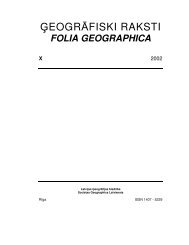eogrÄfiski raksti folia geographica xii - Ä¢eogrÄfijas un Zemes zinÄtņu ...
eogrÄfiski raksti folia geographica xii - Ä¢eogrÄfijas un Zemes zinÄtņu ...
eogrÄfiski raksti folia geographica xii - Ä¢eogrÄfijas un Zemes zinÄtņu ...
You also want an ePaper? Increase the reach of your titles
YUMPU automatically turns print PDFs into web optimized ePapers that Google loves.
MAN AND ENVIRONMENT<br />
Figure 2. Physical-<strong>geographica</strong>l regions of the Gudenieki parish<br />
Research methods<br />
In the study of landscape structure dynamics in the parish, topographic maps of 1929<br />
(showing the situation in 1911) and 1960 have been used, as well as the land use plan of 1990.<br />
For the mapping of overgrown fields aerial photos of 1998 have been used. The analysis of<br />
factors influencing changes in landscape structure is based on statistic data about the territory of<br />
Gudenieki parish, namely, the data of the State Archives concerning the population, collective<br />
farms, the development of the local administrative system; the land use data of Gudenieki parish<br />
and the data from the State Land Service, evaluating the quality of land and maps of the local<br />
authorities during the Soviet period.<br />
Spatial processing of the data and analysis of changes in land use has been carried out<br />
with the help of GIS software Arc View.<br />
Results and Discussion<br />
Despite the differences in relief and soils, agricultural lands predominated in the whole<br />
territory of Gudenieki parish at the beginning of the 20 th century. This factor acco<strong>un</strong>ts for the<br />
dominant open type of cultural landscape (Figure 3a). Larger tracts of forests were situated in<br />
the outlying territories of the parish in damper places with less fertile soils. Small patches of<br />
forests were fo<strong>un</strong>d in both plain and hilly parts of the parish. The structure of settlement<br />
depended on the natural conditions, road infrastructure, and the placement of manor houses.<br />
Owing to more fertile soils, the Apriķi Plain had a denser network of detached farmsteads, in<br />
comparison with Kurmāle Hillock downs and the Piemare Plain.<br />
Detached farmsteads were not erected in the vicinity of manor houses (Figure 3a). The<br />
Adze Manor house, with its surro<strong>un</strong>ding farmsteads, is rather an exception. Manor houses in the<br />
territory of Latvia appeared in the 13 th century. Later in the 14 th century they developed as<br />
centres of agricultural production. The manor houses were usually surro<strong>un</strong>ded by large<br />
cultivated fields. Land owned by peasants was situated in the periphery, where natural<br />
conditions were poorer [Potapova 1977]. The placement of manor house lands in the 14 th -17 th<br />
centuries influenced the distribution of detached farmsteads in Gudenieki parish at the<br />
beginning of the previous century.<br />
58

















